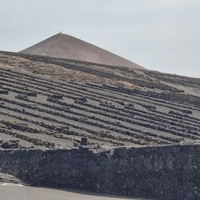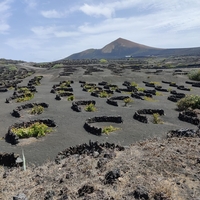My husband and I traveled to the Canary Islands in September to learn about their wines. The first thing we learned was that the phylloxera root louse that almost succeeded destroying the vineyards of Europe never made it to the Canary Islands, so the grapes grow on their own roots instead of being grafter onto phylloxera resistant root stock. Our visit to Tenerife was the topic of my last column. This one is about our visit to Lanzarote. The two islands could not be more different in appearance. The wines on both are quite good.
The first wine I tasted was a 2020 Malvasía Volcánico from the Bermejo Winery ($23, imported by David Bowler Wines). I was charmed by its bright, light yellow color and fresh melon aromas with hints of ripe peaches and saline notes. The floral, melon, citrus fruit is dry, round and intense in the mouth. The grape has an interesting history. The grapes arrived in the Canary Islands in the 1500s, but it took 300 years for it to make it to Lanzarote. So, it has been

growing on Lanzarote for another 300 plus years. It is now considered a unique variety because of its evolution in this unique environment by the International Organization of Vine and Wine.
Another wine from Bermejo was made from a grape I had never tasted, a 2019 Vijariego (pronounced, “vee hah RAY go”) is also called Diego ($15, David Bowler). It is not as aromatic the Malvasia Volcanico, but it creates wines with complexity and the ability to age. Pale yellow color and light lemony aromas leading to forward, layered flavors of salty Meyer lemon and green apple, fresh and very lean perfect with a fresh goat cheese or grilled shrimp. I tasted another Vijariego at a winery that does not ship to the U.S., but it convinced me that this grape can, indeed make wines with complexity and ability to age. It was aged in French oak, and had layers of complexity. It made me think of a white Burgundy.
Lanzarote is the fourth largest and easternmost island of the seven Canary Islands located just under 75 miles from the western Africa coast. Wines were produced on Canary Islands as early as the first decades of the 15th century and the discovery of America created opportunities to supply outbound ships. By the second half of the 16th century Canary wines were so famous that Shakespeare mentioned them in
Twelfth Night and
The Merry Wives of Windsor. However, none of those wines were produced in Lanzarote, because the conditions were not conducive for growing wine grapes or fruit trees. It took a cataclysmic event to make grape growing possible. From 1730 to 1736 Lanzarote endured ongoing volcanic eruptions that destroyed whole villages. The landscape was covered by volcanic ash as deep as six feet. Farmers began to discover that this ash actually provided a benefit. Its cover acted as a mulch, retaining the meager rainfall and morning dew to provide water for vines. It was and still is necessary to dig a funnel-shaped pit (
hoyo) down through the ash to plant the vines. In areas where the volcanic ash is not so deep the vines can be planted in rows, which makes it possible to use equipment.
That mulch is necessary because Lanzarote does not have natural water from rivers or streams. The average annual rainfall is 4.9 to 5.9 inches. The first desalinization plant in Spain was installed in Lanzarote in the mid 1960s. Two additional plants were installed in 1975. According to a research paper by Miguel A. García-Rubio and Jorge Guardiola in the International Journal of Water Resources Development, 99% of consumed water in Lanzarote comes from desalination.
Growers also must contend with the trade winds that blow across the island. To protect the plants from wind damage, they stack volcanic rocks to create a low wall. They leave small spaces in the wall to provide air flow to prevent diseases.

The combination of the black lava sand covering the ground with funnel-shaped pits gives the island’s vineyards a surreal, moonscape appearance.
The major white grape varieties are Malvasía Volcánico, a.k.a. Malvasía de Lanzarote, recognized as a unique variety by the International Organization of Vine and Wine; Listan Blanco, a.k.a. Palomino, Muscat of Alexandria ,and Diego, a.k.a. Vijariego. The main red grape is the indigenous Listan Negro, and occasionally Tintilla and Negramoll.
For native born artist Cesar Manrique, Lanzarote was his greatest work of art. He studied technical architecture at the La Laguna University then moved to Madrid to study at Academia de Bellas Artes de San Fernando. He became an art professor, painter, and Lanzarote’s most famous artist. He lived and worked in Madrid, Paris and New York, then moved back to Lanzarote where he lobbied the regional council to maintain and respect the traditional way of life and buildings on the island. No buildings were to be taller than a Canary palm tree, which can grow to 50-60 feet. Lanzarote was designated a Unesco Biosphere Reserve in 1993. In the Socio-Economic Characteristics they cite the Marique’s work. Unesco’s “vision is a world where people are conscious of their common future and their interactions with the planet, and act collectively and responsibly to build thriving societies in harmony within the biosphere.”
Lanzarote was one of the most interesting places I have visited in a long time. I met several people who moved there from other places in Europe: England, The Netherlands, Italy, etc. When we asked why they moved to Lanzarote, they all said they had not been comfortable with how things were happening in their city or country. To a person they said they loved the lifestyle in Lanzarote.